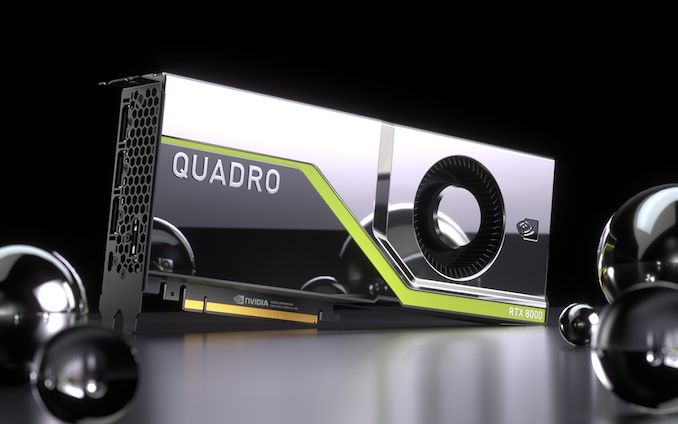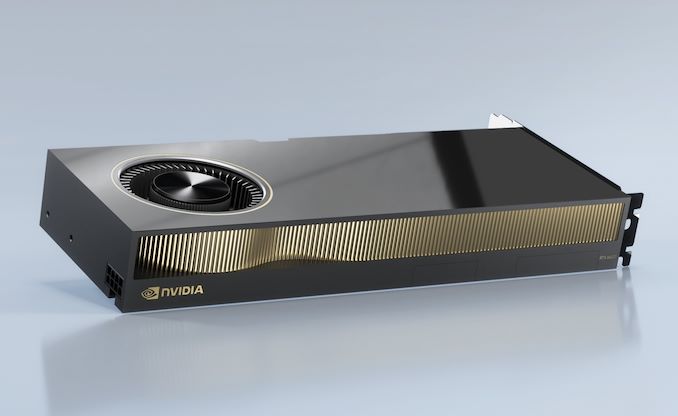More On NVIDIA Quadro Brand Retirement: Embracing the Graphics and Compute Overlap
by Ryan Smith on October 13, 2020 5:45 PM EST- Posted in
- GPUs
- Quadro
- NVIDIA
- Quadro RTX
- Ampere

Now that NVIDIA’s second GTC event of the year has wrapped up, we’ve finally gotten a chance to follow up with NVIDIA on last week’s announcement of their RTX A6000 video card, and what that means for the Quadro brand. In short, NVIDIA has confirmed that the Quadro brand is going away for sure, and as we suspected, it’s largely due to the overlap between graphics and compute.
As a quick refresher, last week NVIDIA launched their new professional visualization-focused video card, the RTX A6000. Based on the new GA102 GPU, the card ticks all the boxes for a high-end, pro-grade video card; and under normal circumstances, it would be part of NVIDIA’s Quadro family of products. However the card was notably excluded from the Quadro family in something of a last-minute change. At the time it wasn’t clear just what this meant for the Quadro brand as a whole, but now that GTC has wrapped we’ve been given some better insights into what’s going on.
First and foremost, NVIDIA has confirmed that the Quadro brand is being retired, or “streamlined” as the company calls it. Similar to the Tesla brand a couple of years back, the brand is set to be slowly retired from the market, as new professional visualization cards are released without the Quadro branding. Going forward, all of these cards will be given brand-less names, such as the “NVIDIA RTX A6000” and “NVIDIA A40”.
The more interesting aspect to this change is why: why would NVIDIA retire one of its oldest video card brands after so long? After all, the market for pro cards isn’t going away, and it remains a tidy, profitable business for NVIDIA. At the time we suspected that this has to do with the increasing overlap in NVIDIA’s product lines between professional visualization cards and compute cards, and the company has since confirmed that our hunch was correct.
As NVIDIA has continued to expand into the compute market, their professional visualization (ProViz) and compute products have increasingly overlapped in terms of features and pricing. As NVIDIA already charges “full” price for both their compute and ProViz cards, there are little-if-any feature differences between the two: desktop ProViz cards have the same access to compute features as compute cards. And compute cards, though almost exclusively server-mounted, can be provisioned as a virtual ProViz card as well.
One of the consequences of which has been that NVIDIA’s own messaging on what cards can do what tasks has become unfocused, never mind potentially confusing customers. If you need an actively-cooled desktop card for running neural network prototyping, for example, what card do you buy? Previously it was the Quadro card, despite the fact that it was a ProViz part. Similarly, the ex-Tesla V100 makes a great part for provisioning a virtual Quadro instance, even though it’s not a Quadro part.
As a result, NVIDIA has opted to go the route of essentially merging their compute and ProViz hardware lineups in an effort to simplify their offerings. NVIDIA wants for there to be a single brand – NVIDIA – which covers both markets, reflecting the flexibility of their cards and (largely) eliminating questions over which cards can be used for graphics or compute. At the same time, this also allows NVIDIA to reduce the number of hardware SKUs offered, as they no longer need overlapping products at the fringes of these markets.
Ultimately, the market for ProViz and for computing has quickly become one and the same. Though the two differ in their specific needs, they still use the same NVIDIA hardware and pay the same NVIDIA “premium”. So both are set to become a single product line to cover the needs of all of NVIDIA’s professional and commercial customers, whatever their graphics and compute needs.











34 Comments
View All Comments
whatthe123 - Tuesday, October 13, 2020 - link
Considering the 3090 does not get quadro validated drivers and is considered "titan class" but not titan, it seems like nothing has changed from that standpoint, so no quadro optimizations on gaming cards for software that requires vendor validation.CiccioB - Wednesday, October 14, 2020 - link
AFAIK that is valid only for OpenCL accelerated applications, while for the rest (compute and DX) the support should be the same as there are lot of those cards sold for 3D rendering.CiccioB - Wednesday, October 14, 2020 - link
I meant OpenGL, not OpenCL, sorrywhatthe123 - Wednesday, October 14, 2020 - link
Support for many opencl and opengl software does not require vendor certification, which was already the case for every gaming GPU even before turing.Anything that requires VENDOR certs (i.e.Siemens NX) do not get accelerated drivers on gaming GPUs, even the 3090 with studio drivers. Confirmed to reviewers by nvidia themselves.
https://i.imgur.com/9Lk1z50.png
https://i.imgur.com/1Xxrzg3.png
CiccioB - Wednesday, October 14, 2020 - link
I was speaking about acceleration options and support, not certification.Certification is needed for certain works or certain working environments, but if work for such markets you can surely afford a certified piece of HW (that has also better HW and controls, like ECC and not only ad hoc drivers).
While, if you use the GPU for doing usual work (be it modeling, rendering or calculations) you can use a 3090 (or even a couple of them) to accelerate all you want, but, as said, few OpenGL applications (but again, if you use them regularly with a paid license the cost of a Quadro, not necessarily the latest most powerful one to just accelerate them, is not a problem).
whatthe123 - Wednesday, October 14, 2020 - link
If you actually read nvidia's comment on the matter, it is 100% driver related, not ECC related. 3080/3090 do not ship with driver side optimizations for software that requires vendor certs. Software like blender does not require certs and will run normally regardless of gaming or quadro hardware, but you can see in the specviewperf test that NX simulation runs 21x worse on a 3090 than a titan, which hardware wise makes absolutely no sense and is entirely due to its driver.whatthe123 - Wednesday, October 14, 2020 - link
In case it wasn't clear, there is no piece of hardware on the RTX titan that performs 21x faster than the 3090, including the tensor cores and error correction, yet the titan is indeed 21x faster in NX sim and slightly faster in solidworks even with slower hardware.Kakkoii - Wednesday, October 14, 2020 - link
Nvidia releases "Studio" drivers now that contain those acceleration unlocks.And as CiccioB mentioned, this has only ever really applied to certain OpenGL applications. The DirectX and OpenCL interfaces are completely wide open on the gaming cards, there are no artificial limitations put in place there because many games are now using the GPU for compute so Nvidia and AMD had to give in to studio demand.
boeush - Tuesday, October 13, 2020 - link
"can be provisioned as a virtual ProViz"- with the proviso that it's done by a pro vis a vis the provisioning for the ProViz
wolfesteinabhi - Wednesday, October 14, 2020 - link
it may also allow them to price them lower or compete with AMD on pricing .. incase their new RDNA/CDNA cards are any good.(to me this move by nvidia looks similar to how Intel was moving its "platinum" cpus to "gold" tier with new name ..to price them lower,etc)